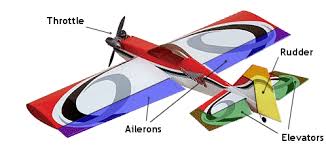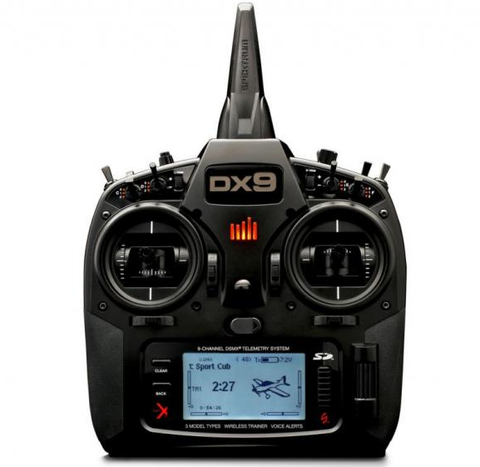If you are a beginner and want to start with the hobby of flying radio controlled planes you made a great decision! It is fun, you are out in the open, a great way to relieve stress, as expensive as you make it, it never gets boring and you will meet some great people!
How do you start? You want to have fun, but also there is a great deal of things to learn along the way.
Choice of material
The first thing you need to decide on is which plane and radio or remote control you will buy.
There are all kinds of planes build with all kinds of materials. To start it is best you buy a foam trainer plane. Why foam? It is more robust then a wooden plane and essayer to repair in case you crash. Advanced pilots often choose a wooden plane because it has better flight characteristics. But that is not an issue when you are going to learn to fly. Why a trainer? It has the wing on top off the fuselage. Because of that it tends to 'auto-balance' itself when you let go of the control sticks.
There a many great manufacturers of beginner planes. Horizon Hobby (Eflite) has some great planes to start with. Why? Because they have planes equipped with Safe and they make quality products for a fair price.
Some excellent beginner planes are the Apprentice RC plane and the Timber RC plane. Both are available in our webshop and a few of the best RC beginner planes.
E-flite Apprentice RC plane
E-flite Timber RC plane
Bellow some abbreviations explained, so you will understand what to buy.
SAFE (Sensor Assisted Flight Envelope) stabilizes the plane in the air (after pushing a button on your remote control) very quick when you panic or loose control . This did safe my beginner plane from crashing many times.
RTF (Ready-to-fly) The box you are buying contains everything you need to fly. The plane, the remote control, a signal receiver in the plane, the battery, the charger, etc...
BNF (Bind-and-fly) The BNF RC plane you are buying is ready to fly but it misses some stuff before you can start flying. You always need a remote control. And often a correct battery (lipo), a battery charger, etc... The exact list of things needed to complete is in product description of each plane on our webshop.
ARF (Almost ready-to-fly) The plane is build but it needs an engine , an ESC (Electronic Speed Control for the engine) in case you use an electric engine, a receiver, .... This type of kit is often bought by the experienced pilot because they can decide which equipment they put in the plane. If you don't know we can advice and help you with this at the shop.
There are also many great radio's from different manufactures on the market. Spektrum RC (Horizon Hobby) is a great good beginner choise because they can provide you with an inexpensive radio that can store multiple plane configurations and a user-friendly interface. Preventing you from needing to buy a new radio when you buy your next plane.
Depending on how much you want to spend some great beginner radio's are the DX6, DX6i, DXe, DX5e and the DX4e. The DX6 is a programmable radio which allows you to control planes, drone, heli's and gliders and swap between configurations depending on what you are going to fly. More advanced radio's are the DX7, DX8. Very advanced radio's are the DX9, DX18 and DX20. For an extended explanation between the differences please check the product pages in our webshop or contact us at the store.
The Spektrum DX9
How does it work?
A radio or transmitter has 2 sticks. If you move them , a radio signal is sent to the receiver in the plane. This receiver sends electrical signals to servo's which move the control surfaces of a plane. The primary control surfaces of a plane are rudder, elevators and ailerons. Some planes have less control surfaces. When your plane has all three primary control surfaces and the throttle you have a four channel plane. This means you need a least a four channel radio. The more advanced planes have more channels to control like for example the gear.


The mode determines which stick/channel controls which surface. Most people these days fly with mode 2. But this is a personal choice.

What is next?
Try to get the help of an experienced pilot. There are many things to understand and getting the help of an experienced pilot in this stage is priceless. If you don't have a friend or a family member who can help you the best option is to go to a club. You will find some great people there. This link forwards you to the organisations in Belgium who registers and controls the club in Belgium. Also you will find some valuable info about the laws in Belgium for flying remote controlled planes.
Do not attend your first flight alone. It is dangerous and could injure another person. Make sure you have somebody with you who knows what he/she is doing.
Flying a remote plane is not rocket sience but almost never goes ok the first flight without any help.
Some tips
- Choose a calm, sunny day with no wind. Wind adds an extra level of difficulty which you do not need at your first flight.
- Do not fly near other people or obstacles but go to a club or a very big, open field. Also check the law in your country on what is allowed and what is not.
- Take many flights with low risk. Progress will come when you fly much. Doing to much at once will result in a crash.
- Focus on learning one maneuver at a time. This gives the best results.
See you at the field!



